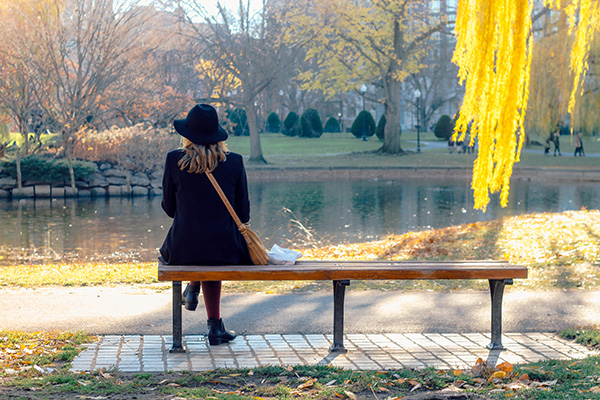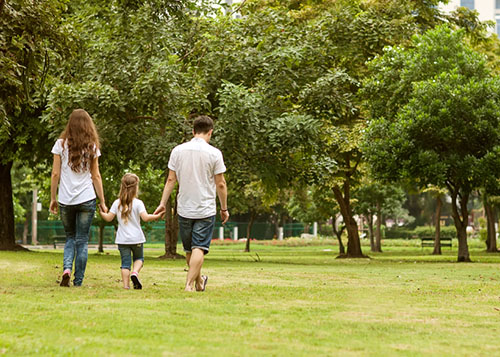 Woman relaxing on a park bench at a local park. A new resource called "ParkServe" shows the public how well their city ranks when it comes to providing parks close to people
Woman relaxing on a park bench at a local park. A new resource called "ParkServe" shows the public how well their city ranks when it comes to providing parks close to people
We all know the benefits of relaxing on park benches or running around playgrounds in a local park.
Studies have repeatedly shown that sunshine, fresh air and greenery are a powerful influence on our well-being.
But what if it took 30 minutes or an hour for you to get to a park?
How often would you find yourself sitting on that park bench enjoying a view of a pond with a few ducks paddling around? How many times would a mom pack her children into a car to drive them across town to hang on the monkey bars?
Probably not too often.
The Trust for Public Funds is looking to change that paradigm and encourage cities to add more parks that people can easily reach within a 10-minute walk.
And they created a cool online tool for people to see how their cities ranks for accessible parks.
"In hundreds of cities across America kids have no safe places to play," the Trust reported in a video about their program. "This is no way to grow up."
To change that situation, the Trust has embarked on a very ambitious program.
To start the program, the Trust had to come up with a computerized system and database to identify areas where there was a large gap between the population and public green spaces.
That was quite an undertaking.
In phase one, the organization developed a platform that will evaluate 19,931 communities in America.
Last year, they had amassed data on 7,691 cities, towns and communities. That was nearly 70% of the US population.
For each park, the team had to integrate geospatial data on the location of parks with walkways in those communities. The Trust then used population figures gathered by the 2015 Census to determine where people lived.
Areas that fell outside the 10-minute walk radius were then identified. Extra weight was given to areas where there was a higher density of people, a higher density of children under 19 years of age and households with income less than 75% of the regional median household income.
Check out how your city ranks for park accessibility
As you can imagine, that's quite a bit of data. However, data and statistics in themselves can be well, kind of boring.
So to make all that data more meaningful, the Trust created an interactive online resource called "ParkServe."
With ParkServe, anybody can enter their city in the search bar. The site's database then crunches the numbers and produces a simple report with a top line overview on the park situation in a specific community.
For example, we conducted a query for Boca Raton, FL, (home of The Park and Facilities Catalog).
Here are the results:
- 50% of residents live within a 10-minute walk of a park
- There are 37 parks within the city
- There are 568 total acres of parkland within city limits
- The median park size is 8.7 acres
- There is 1 acre of parkland for every 153 people.
- The largest park was identified as "Sugar Sand Park" with 131.73 acres.
There's another result that can be a great resource for any citizen or public official who wants to add more parks to their community.
The ParkServe page calculates how your town rates compared to the national average for the Percent of Youth Within a 10 Minute Walk to A Park.
For Boca Raton, the findings showed the City's Average of People to Parks was 49%. That compares to the National Average of 55%.
(By contrast, Seattle, WA, provides parks within a 10-minute walk to 96% of its citizens. Naturally a big city will have higher density than a smaller city).
Still, that's not a bad report card for Boca Raton.
However, there is that one number at the top of the screen that might catch the attention of local officials.
Only half the population is within a short walk to a park. That might be something that needs addressing.
And here's probably the most powerful tool offered by the ParkServe website.
Click on the map button and the website's geospatial functionality will show a map designating several places within city limits where parks are recommended. (The map also shows the current location of parks).
The map prioritizes these areas with color-coding - Red areas show a "Very High" need. Orange areas are "High" and a beige designation shows a "Moderate" need.
Viewers can zoom into the map to show closer details of the areas along with major roadways.
 Family taking a stroll in a park. How close is the nearest park to people in your town? Check "ParkServe" to see where parks are needed in your community
Family taking a stroll in a park. How close is the nearest park to people in your town? Check "ParkServe" to see where parks are needed in your community
What a powerful way to illustrate the need for more parks.
What a great, geospatial tool that local citizens can use to campaign for the construction of a park near them.
Adding more parks, does not necessarily have to be a major, expensive endeavor, like creating a new Central Park in NYC.
In recent years, small "pocket" parks have started to spring up all over the country.
All you need is a patch of green space, some park benches, maybe a sandbox or a swing, a few trees for shade and guess what? You've created a nice place for people to hang out, catch some rays, meet some friends or just interact with nature.
The Trust said it is working to promote more parks as places "where everyone can play, exercise, connect with nature and with each other."
Sure, in major cities, where rents are high and land is more likely to be used for skyscrapers and apartment building, space is sparse.
However, the Trust noted great patches of land are being reclaimed from old rail yards, abandoned factory waterfronts and vacant, trash-filled lots.
These spaces can be transformed into places where people can jog along a river, play basketball or read a book on a park bench.
One great example is the High Line park in New York City. The city took an elevated rail line and transformed it into a string of parks that weave throughout parts of the city.
Visit the High Line on a weekend and you will be amazed on how many people that park attracts. There's music playing, people talking on park benches or others just out for a nice stroll above the asphalt and the traffic.
In Miami, Fl., The Underline park is being developed to use open spaces under the Metrorail line to put together a string of parks where people can ride bikes, jog or just hang out in the shade of the train tracks.
Use the ParkServe tool to campaign for parks near you
"ParkServe democratizes park information, giving local leaders and individual residents the information they need to advocate for more parks," said Adrian Benepe, Director of City Park Development for Trust.
If you are a local citizen, perhaps you can use the data in the ParkServe tool to rally your neighbors to approach city officials to add a park near you.
If you are a park and recreation director, you can use this information to argue for a larger budget for more parks to better service the needs of the public.
Any group can also contact the Trust for Public Land for assistance.
This is one issue just about every citizen can agree upon. Parks are precious. They improve the quality of life in any community. Most people and elected officials realize this.
But the Trust for Public Lands took this notion one step further.
Parks can be truly precious if everybody in a town has close access to one.
The Trust's database now points this out. Sure, mega parks are great and attract quite a few people.
But what good is a gigantic park if only a certain group can get to it on a regular basis?
Use the Trust's search tool to identify local opportunities in your town. It doesn't take much to build a park: find a patch of land and add some plants, a few park benches and picnic tables.
But living within a short walk to that park can have quite a big impact on the quality of a person's life, both young and old.


